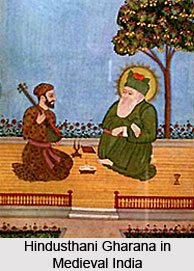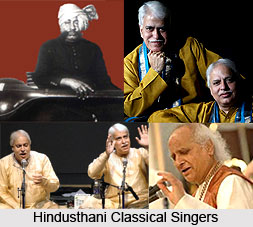 Gharana refers to a family of musicians, a school of music or a musical lineage connected with the name of a particular person or place. The characteristic feature of a Gharana is its special style of presentation. Musicians of the Gharana have their own individual styles of presentation, but their training and conditioning in the distinguishing style of the Gharana leaves indelible marks on the presentation of the performer.
Gharana refers to a family of musicians, a school of music or a musical lineage connected with the name of a particular person or place. The characteristic feature of a Gharana is its special style of presentation. Musicians of the Gharana have their own individual styles of presentation, but their training and conditioning in the distinguishing style of the Gharana leaves indelible marks on the presentation of the performer.
The word `gharana` has its roots in the Hindi word ghar (rooted in the Sanskrit word griha) which means house or rather specifically `of the house`. The diffusion of traditions in music included vital components like voice training, use of particular ornaments, the inculcation of pedagogic and performative subtleties and importantly, characteristic styles of aesthetic thinking.
Origin of Gharana
Hindustani Classical Music or North Indian Classical Music has always undergone steady growth but at times it has also suffered a setback and stagnation over the last few hundred years. Majority of the Muslim rulers were disinclined towards music as it was stated in their religion. However a few of these emperors became great lovers of Indian music and art. Hence they encouraged the development of music and welcomed many great musicians in their courts from their native lands. The nature and foundation of the princely courts of North India, their impressive geographical seclusion, their enshrinement of music and related arts as a vital part of their ethos, were possibly a few external factors that contributed to the origin and perpetuation of the gharana system.
Initially gharanas were exceedingly closed groups either reinforced by marriage or bonded by blood ties. All musical secrets were then zealously guarded. Outsiders were not permitted to watch or even audit a music training session. It was till the end of the 19th century and the beginning of the 20th century many gharandeer musicians refused to take or teach students with whom they don`t share a blood tie.
The gharana tradition, as one understands today, evolved in Hindustani classical music during the 19th century and the early part of the 20th century, primarily in the ambience of certain royal courts of the native states in Central and North India. A gharana represents a distinctive musical style or idiom, founded and perpetuated by an outstanding artist or an assemblage of great artists.
 Types of Gharanas
Types of Gharanas
The differences between the varied types of gharanas lie in the way each exponent of distinct gharanas emphasize on specific musical aspects. The aspects like emotional expression, voice production and the aesthetic stress given to the use of swara, , tala and laya in their rendition offers a specific contour in representing each distinct gharanas.
Without a doubt therefore it can be said that the proliferation of gharanas happened with the growth of Dhrupad and Khayal as two distinctive art form of art. This later gave birth to a number of Dhrupad Gharanas and Khayal Gharanas.
Dhrupad Gharanas: Dhrupad is one of the ancient existing forms of North Indian classical music, still mirroring its historic origin amidst its aesthetic qualities. The continuity of dhrupad as a contemplative and meditative form therefore has been sustained by traditions and by the various dhrupad gharanas.
Khayal Gharana: The history of Indian music reckons khayal as a flowery form of vocal singing assumed to be the creation of Amir Khusro. Khayal gharanas strictly followed the "Guru Shishya parampara" system in which direct and personal supervision offered a rather creative understanding. Every Khayal Gharana has a few distinct features, a novel facet of their own which allows one to discriminate between the different schools while enabling one to identify the varied approach.




















